Códice Casanatense
The Códice Casanatense, its popular Portuguese title, or the Codex Casanatense 1889, is a set of 16th century Portuguese illustrations, which depict peoples and cultures whom the Portuguese frequently had contact with around the Indian and Pacific oceans. It is now kept at the Biblioteca Casanatense in Rome, with the official designation of Album di disegni, illustranti usi e costumi dei popoli d'Asia e d'Africa con brevi dichiarazioni in lingua portoghese ("Album of drawings, illustrating the uses and customs of the people of Asia and Africa with a brief description in Portuguese language").
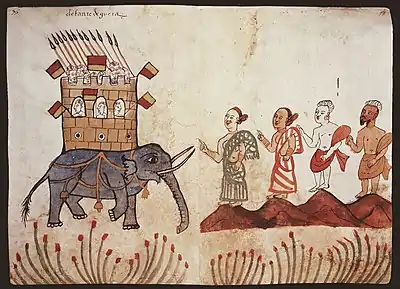
Contents and origin
The codex consists of seventy-six watercolour illustrations, one of which is a later addition. Most come with a short description, and include illustrations of people from east Africa, Arabia, Persia, Afghanistan, India, Ceylon, Malaysia, China and the Moluccas, as well as some insights into fauna, flora and certain traditions, such as the Hindu religion - previously unknown in Europe. The creator has not been identified and many hypotheses have proven inconclusive.[1][2][3] Several of its inscriptions provide information as to the date it was made, namely the allusion to the Siege of Diu of 1538, but the absence of any mention of the Japanese, whom the Portuguese contacted in 1541-43.[2] It is therefore possible it was made circa 1540.[4]
Its earliest recorded owner was the novice João da Costa of the College of St. Paul of Goa, who in 1627 sent it to Lisbon, according to information inscribed within the codex. Once in Europe, it was acquired by Cardinal Girolamo Casanata who, on his death in 1700, bequeathed it along with his private collection to the Dominican Order, for the creation of a new library, where it is now kept.[5] It was first brought to public attention by the scholar Georg Schurhammer, who published several pictures in the Portuguese historical magazine Garcia da Horta in the 50s.[6]
The Códice Casanatense provides an extremely rare insight into the culture of the peoples in Africa and Asia 16th century, and is especially valuable for the study of popular arms and garments of the era.
Gallery
Abyssinia
 Abyssinian warrior and his wife
Abyssinian warrior and his wife
Nubia
 Nubians
Nubians
Cafreria
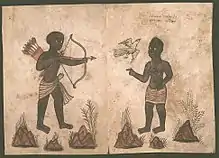 Cafres of the Cape of Good Hope.
Cafres of the Cape of Good Hope.
Arabia
 Bathing scene of the women of Muscat.
Bathing scene of the women of Muscat. Inhabitants of the Kingdom of Fartakh in the east Arabian coast and Socotra, called Fartaques by the Portuguese .
Inhabitants of the Kingdom of Fartakh in the east Arabian coast and Socotra, called Fartaques by the Portuguese . Arabian merchants from the Hejaz.
Arabian merchants from the Hejaz. Farmers from south-eastern Arabia, possibly Yemen, called Boduis by the Portuguese.
Farmers from south-eastern Arabia, possibly Yemen, called Boduis by the Portuguese. "Sailors" from Arabia, probably fishermen.
"Sailors" from Arabia, probably fishermen. Sailors from Arabia, repetition
Sailors from Arabia, repetition
Mesopotamia
 "Rumes" (Turks) that inhabit the Red Sea and Basra.
"Rumes" (Turks) that inhabit the Red Sea and Basra. Marsh Arabs.
Marsh Arabs.
Hormuz
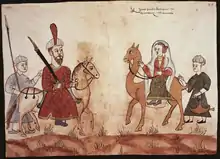 Persian couple from Hormuz.
Persian couple from Hormuz. A dinner of Portuguese in Hormuz. The climate was hot enough that people purposely flooded their homes.
A dinner of Portuguese in Hormuz. The climate was hot enough that people purposely flooded their homes.
Persia and Afghanistan
 A couple from Shiraz
A couple from Shiraz A couple from Khorassan
A couple from Khorassan Turkmens from Persia.
Turkmens from Persia. Nautaques, Baloch fishermen who also attacked trade ships.
Nautaques, Baloch fishermen who also attacked trade ships.
Sindh
 Sindhis
Sindhis
Gujarat
 "King of Cambay", the Sultan of Gujarat.
"King of Cambay", the Sultan of Gujarat. Rajputs, "who inhabit the backwoods of Cambay"
Rajputs, "who inhabit the backwoods of Cambay"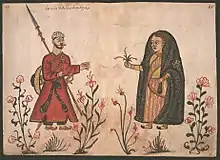 Gujarati couple of a lascarin (foot-soldier) and his wife.
Gujarati couple of a lascarin (foot-soldier) and his wife. Moneychanger of Gujarat
Moneychanger of Gujarat Merchants of Gujarat
Merchants of Gujarat Water tank in Gujarat
Water tank in Gujarat Water sellers of Gujarat
Water sellers of Gujarat Gujarati women
Gujarati women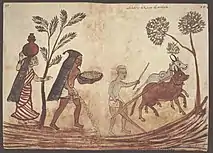 Farmers and land-workers of Gujarat
Farmers and land-workers of Gujarat Carriage of Gujarat
Carriage of Gujarat
Northern and north-eastern India
 Horsemen from Patna
Horsemen from Patna Horsewomen from Patna
Horsewomen from Patna Bengalis
Bengalis
Goa and the Kanara Coast
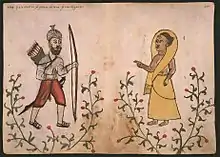 Goan footsoldier, who were known to use longbows.
Goan footsoldier, who were known to use longbows. Goan blacksmiths
Goan blacksmiths Clothes-washers, called mainatos by the Portuguese
Clothes-washers, called mainatos by the Portuguese Wheat-sellers in Goa
Wheat-sellers in Goa Goan farmers
Goan farmers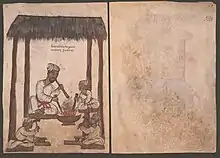 A Brahmin goldsmith from Goa
A Brahmin goldsmith from Goa Hindu Kanarese, called "gentiles" by the Portuguese.
Hindu Kanarese, called "gentiles" by the Portuguese.
Malabar Coast
 Nayars or Nairs, a Hindu "warrior" caste of the Malabar coast
Nayars or Nairs, a Hindu "warrior" caste of the Malabar coast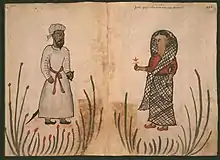 Descendants of Muslim men married to Indian women, called Naitás ("Navayats") by the Portuguese.
Descendants of Muslim men married to Indian women, called Naitás ("Navayats") by the Portuguese. Malabarese Christians of Saint Thomas
Malabarese Christians of Saint Thomas Malabarese Muslims (Mappila)
Malabarese Muslims (Mappila) Malabarese Jews
Malabarese Jews
Maldives
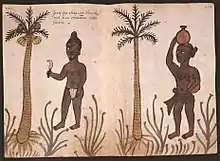 Maldivians
Maldivians
Coromandel Coast
 Badagas, who inhabited the south-eastern coast of India.
Badagas, who inhabited the south-eastern coast of India. People from Orissa, in the eastern coast of India.
People from Orissa, in the eastern coast of India.
Ceylon
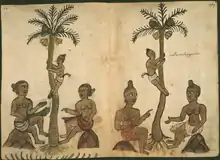 Women of Sri Lanka
Women of Sri Lanka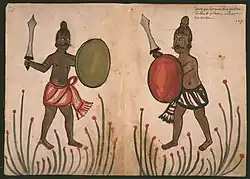 "Chingalas". Warriors of Sri Lanka, "where the cinnamon is born".
"Chingalas". Warriors of Sri Lanka, "where the cinnamon is born".
Burma
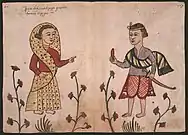 People from the Kingdom of Bago
People from the Kingdom of Bago
Malacca
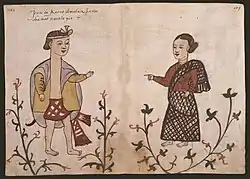 Malay "gentiles" of the Kingdom of Malacca.
Malay "gentiles" of the Kingdom of Malacca.
Indonesia
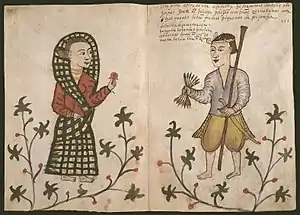 Acehnese people.
Acehnese people.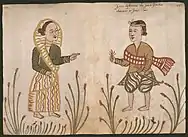 Javanese people.
Javanese people.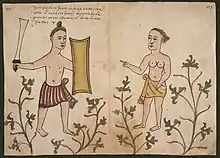 People from Halmahera, also known as Gilolo.
People from Halmahera, also known as Gilolo.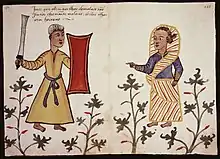 Moluccans
Moluccans Bandanese.
Bandanese.
China
 Chinese
Chinese
Miscellaneous
Hindu rituals
 Illustration of the three main deities of Hinduism.
Illustration of the three main deities of Hinduism. Hindu marriage, left
Hindu marriage, left Hindu marriage, center
Hindu marriage, center Hindu marriage, right
Hindu marriage, right Hindu ritual of hook swinging.
Hindu ritual of hook swinging. Hindu self-sacrifice
Hindu self-sacrifice Hindu self-sacrifice
Hindu self-sacrifice Hindu pilgrims and roving holy men
Hindu pilgrims and roving holy men Burial of a living widow
Burial of a living widow Hindu temple car, crushing a worshipper.
Hindu temple car, crushing a worshipper.
The Portuguese in Asia
 A Portuguese nobleman with his retinue in India.
A Portuguese nobleman with his retinue in India.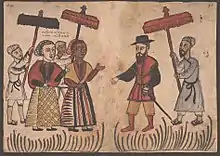 "Single Christian women of India" wearing European fashion, and a Portuguese nobleman, presumably proposing marriage.
"Single Christian women of India" wearing European fashion, and a Portuguese nobleman, presumably proposing marriage. Portuguese noblewoman on a palanquin
Portuguese noblewoman on a palanquin
Fauna and flora
 Illustration of a Naja snake and a mysterious two headed snake.
Illustration of a Naja snake and a mysterious two headed snake.
See also
Notes
- Matos 1985, p. 23.
- Losty, Jeremiah. "Codex Casanatense 1889: an Indo-Portuguese 16th century album in a Roman library". Retrieved 26 January 2018. Cite journal requires
|journal=(help) - Thomas, David; Chesworth, John A. (17 December 2014). "Christian-Muslim Relations. A Bibliographical History.: Volume 6. Western Europe (1500-1600)". BRILL. Retrieved 26 January 2018 – via Google Books.
- Matos 1985, p. 28.
- Matos 1985, p. 29.
- Matos 1985, p. 19.
References
- De Matos, Luis (1985). Imagens do Oriente no século XVI: Reprodução do Códice português da Biblioteca Casanatense. Lisbon: Imprensa Nacional Casa da Moeda.